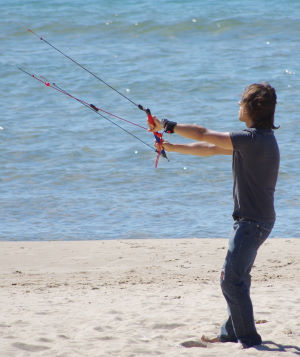Choosing a Kiteboarding Trainer Kite
Choosing a Kiteboarding Trainer Kite
People often ask, "What's the best trainer kite?" My answer is always the same, "It depends on what you are looking to do with it." True, some trainer kites have additional features that make the flying experience a little easier; however, these additional features don't necessarily make the kite the right choice for you.
Let's start with the size of the kite. Trainer kites can be as small as 1.7 meters, or as big as 5 meters. These "meters" are surface meters, and every .5 meters you gain in size will give the user approximately 30% more pulling power.
To put this into perspective, let's compare a Rush 300 (3 meter kite) to a Rush 350 (3.5 meter kite). Where the Rush 300 has a wind range of 4-29mph, the Rush 350 has a wind range of 4-21mph. This means that a Rush 350 can be flown in lighter winds with the same amount of pulling power as a Rush 300 in a little stronger wind.

The standard trainer kite is equipped with 2 lines which enable the user to steer the kite in the direction they choose. Examples of these are the Symphony 1.7m, the Rush 300, and the Rush 350. Some trainer kites, however, have an additional third line. This third line doesn't influence the way the kite flies, but it does aid in convenience and safety.
When learning to fly a kite, it is almost a guarantee that you will crash the kite more than a few times. If you are flying a 2 line trainer kite and the kite goes down, the only way to re-launch it is by having someone else flip the kite over or by flipping it over yourself. If you're flying alone and you put a 2 line trainer on the ground, you will need to unstrap the leash and walk the lines until you reach the kite. Once you reach the kite, flip it over and place some sort of weight on it to hold the kite down (sand, kite bag, etc.). When this is done, you can then go back, strap in, and prepare to launch again.
 Many people find that to be a bit inconvenient. That's where the third line comes in. If the kite crashes, you simply pull on the third line and the kite will automatically flip itself over. This ensures the flying never becomes frustrating.
Many people find that to be a bit inconvenient. That's where the third line comes in. If the kite crashes, you simply pull on the third line and the kite will automatically flip itself over. This ensures the flying never becomes frustrating.
Even more important than convenience is safety. When you let go of a 2 line kite, a strap connected to the bar will not allow the kite to blow away; however, this doesn't always mean the kite will go to the ground. Letting go of a 2 line kite will simply make the kite spin around uncontrollably. If you are planning on flying in a busy area, this could be something to keep in mind.
When you let go of a 3-line kite, the third line (which extends through the bar and connects to your strap) will have all the line tension while your other 2 steering lines will slack. This will then fold the wings of the kite together and drop the kite immediately. So if you are flying the kite and suddenly a powerful gust comes through, you can let go rather than be blown off your feet. For those looking to use a trainer kite to pull them with a skateboard, a 3 line option is definitely the way to go. Examples of 3 line trainer kites include the Rush 300 pro, the Rush 350 pro, the Hydra 300, and the Hydra 350.
 The last thing to consider when choosing a trainer kite is whether or not you want it to be able to water re-launch. The Hydra 300 and the Hydra 350 are both 3 line closed cell foil trainer kites that do just that. The Hydras have a zipper on the back that is shut when in use. The user will steer the kite skyward, and the kite will fill in with air. When zipped shut, the kite will hold all of the air even when the kite crashes (this allows the kite to float). Because the kite is a closed foil, air is able to fill the kite and give it structure, but water is not able to sink the kite when it crashes. If you live in an area near water, or are looking for the perfect kite to body drag with, the Hydra is certainly a good choice.
The last thing to consider when choosing a trainer kite is whether or not you want it to be able to water re-launch. The Hydra 300 and the Hydra 350 are both 3 line closed cell foil trainer kites that do just that. The Hydras have a zipper on the back that is shut when in use. The user will steer the kite skyward, and the kite will fill in with air. When zipped shut, the kite will hold all of the air even when the kite crashes (this allows the kite to float). Because the kite is a closed foil, air is able to fill the kite and give it structure, but water is not able to sink the kite when it crashes. If you live in an area near water, or are looking for the perfect kite to body drag with, the Hydra is certainly a good choice.
So again, kites will vary based on size, number of lines, and whether they are open or closed foil kites. Once you determine what you will be using the kite for, you can then figure out which one is best for you.

